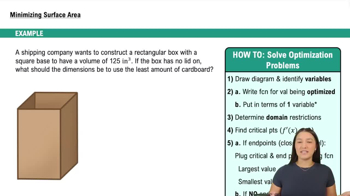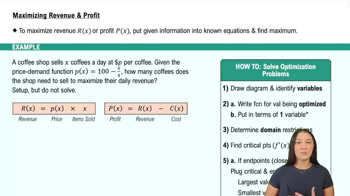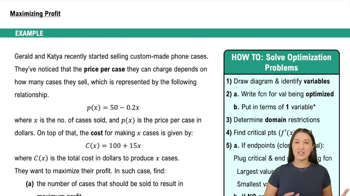Table of contents
- 0. Functions7h 52m
- Introduction to Functions16m
- Piecewise Functions10m
- Properties of Functions9m
- Common Functions1h 8m
- Transformations5m
- Combining Functions27m
- Exponent rules32m
- Exponential Functions28m
- Logarithmic Functions24m
- Properties of Logarithms34m
- Exponential & Logarithmic Equations35m
- Introduction to Trigonometric Functions38m
- Graphs of Trigonometric Functions44m
- Trigonometric Identities47m
- Inverse Trigonometric Functions48m
- 1. Limits and Continuity2h 2m
- 2. Intro to Derivatives1h 33m
- 3. Techniques of Differentiation3h 18m
- 4. Applications of Derivatives2h 38m
- 5. Graphical Applications of Derivatives6h 2m
- 6. Derivatives of Inverse, Exponential, & Logarithmic Functions2h 37m
- 7. Antiderivatives & Indefinite Integrals1h 26m
- 8. Definite Integrals3h 25m
5. Graphical Applications of Derivatives
Applied Optimization
Problem 76b
Textbook Question
Turning a corner with a pole
What is the length of the longest pole that can be carried horizontally around a corner at which a corridor that is a ft wide and a corridor that is b ft wide meet at right angles?
 Verified step by step guidance
Verified step by step guidance1
Visualize the problem by drawing a diagram of the two corridors meeting at a right angle, labeling the widths of the corridors as 'a' and 'b'.
Identify the relationship between the length of the pole and the geometry of the corridors, noting that the pole must fit within the confines of the two corridors as it turns the corner.
Use the Pythagorean theorem to express the length of the pole in terms of the distances from the corner to the points where the pole touches the walls of the corridors.
Set up an equation that represents the length of the pole as a function of the angle at which it is held while turning the corner.
Differentiate the function to find the maximum length of the pole, and solve for the critical points to determine the longest possible length.
Was this helpful?

 1:13m
1:13mWatch next
Master Intro to Applied Optimization: Maximizing Area with a bite sized video explanation from Callie
Start learningRelated Videos
Related Practice









